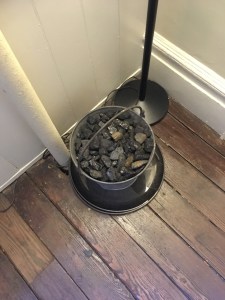| Edification value | |
|---|---|
| Entertainment value | |
| Should you go? | |
| Time spent | 104 minutes |
| Best thing I saw or learned | In mid-19th C. New York rowhouse-style mansions, bedrooms were semi-public space. When you came calling, you’d first go upstairs to a bedroom where you’d leave your coat and hat and change from street shoes to indoor shoes. Only then would you go down to the parlor. Seems strange to me– like they should’ve had a changing room as part of the floorplan. But even in these grand houses, space was at a premium. |
The Merchant’s House Museum is a venerable 19th century home and maybe the only historic house in the city where so many of the furnishings on display are actually original to the house, owned by the home’s owners and maintained by the museum to this day.

The merchant in question is a guy named Seabury Treadwell, who bought the house for $18,000 in 1835. His family lived there for 90 odd years, and by a series of fortuitous events, the house and all the stuff in it became a museum in 1936. In 1965, when the Landmarks law was passed, the Merchant’s House Museum was among the very first places to be landmarked by the city.
 The rooms you can visit today give a pretty good feel for what life was like, and include the downstairs, “family only” parlor, the kitchen, the two main floor parlors (one of which is set up as a dining room), Mr. and Mrs. Treadwell’s bedroom
The rooms you can visit today give a pretty good feel for what life was like, and include the downstairs, “family only” parlor, the kitchen, the two main floor parlors (one of which is set up as a dining room), Mr. and Mrs. Treadwell’s bedroom s and Mr. Treadwell’s study, and one of the servant’s rooms on the top floor. There’s also a very nice back garden, though it’s probably not how that space would’ve looked historically. Sounds like the outdoor space behind rowhouses was mainly used by the help for drying laundry and such, and to provide a space between the house and the outhouse.
s and Mr. Treadwell’s study, and one of the servant’s rooms on the top floor. There’s also a very nice back garden, though it’s probably not how that space would’ve looked historically. Sounds like the outdoor space behind rowhouses was mainly used by the help for drying laundry and such, and to provide a space between the house and the outhouse.
The house is federal style, and true to the style placed a huge premium on symmetry, to the point of having a fake door in the front parlor, needed solely because the back parlor also has two doors.


The Treadwells had 8 kids, and a staff of four, and as the kids grew, at least two married and started their own families in the house. So, even though it’s pretty big, I imagine lots of people living rather on top of one another.
Rather than explore the house on my own (which you can do, with a big binder of facts to keep you company) I took a guided tour with a fellow named Rich Pipphen, who was terrific, and really helped bring the place to life.
Naturally as with all historic things in New York these days, there is a Hamilton connection. Seabury Treadwell’s uncle was the Reverend Samuel Seabury, who was a loyalist during the revolution and got into a fight via pamphlet with Alexander, who wrote “A Farmer Refuted” about him.
One thing I noticed was an absence: the walls throughout the house are a very plain off-white. It’s striking given that I tend to think of homes in that time as having wallpaper or dark paint, but I asked and they said they’ve studied the walls very carefully and the boring off-white is accurate. It makes sense to me, in that it helps make the murky interiors a little lighter than they’d otherwise be. But it’s still surprising.

If you like history, it’s definitely worth a visit. My only small disappointment is I wish there was a little more to see; one whole floor (the kids’ bedrooms) is now offices, not open to the public. Still, it does give you a sense of what life was like (cold, smelly, inconvenient, dark), the ups and downs of this particular family, and the lucky circumstances that preserve this tiny sliver of Old New York.
Reference: Merchant’s House Museum


One Reply to “Merchant’s House Museum”
Comments are closed.